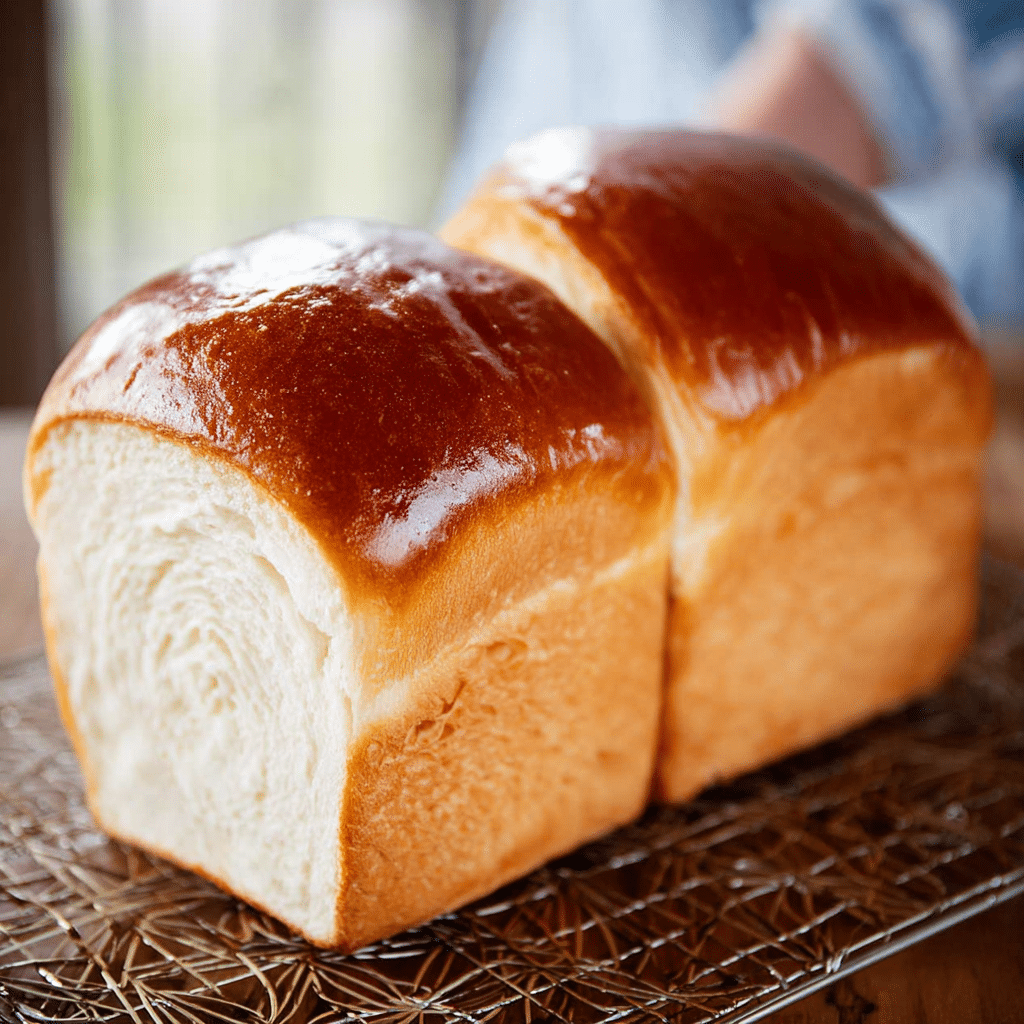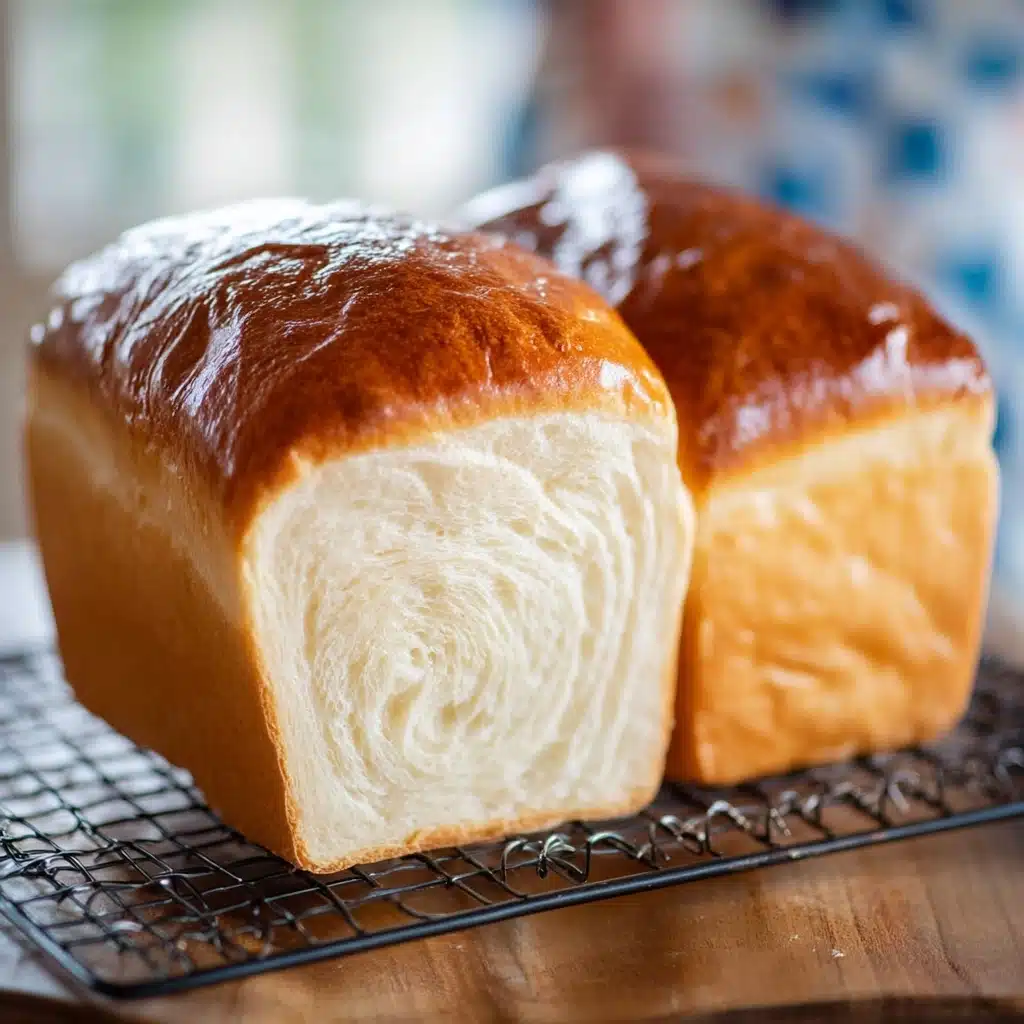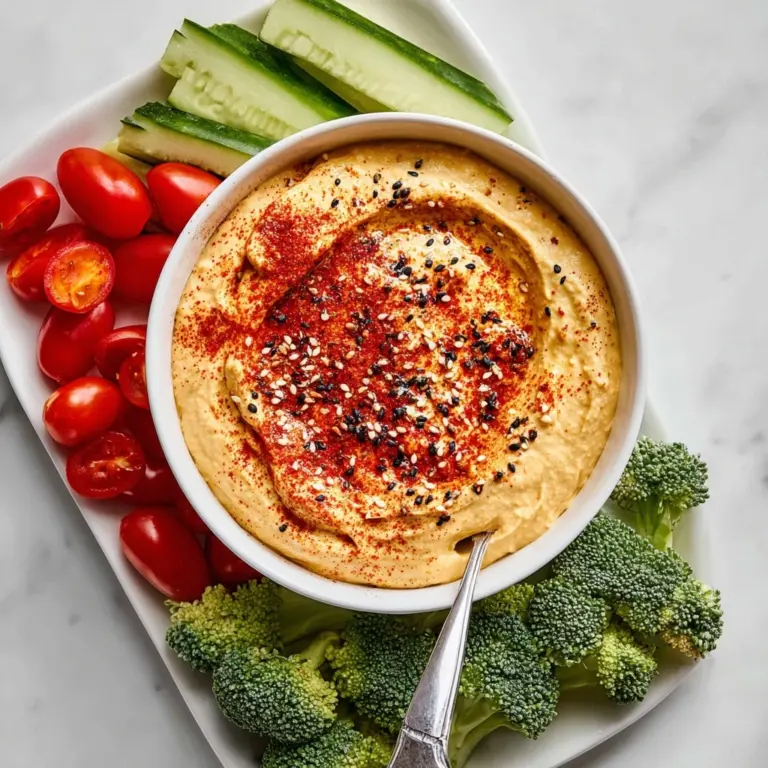Shokupan Recipe
If you have a special place in your heart for bread that is fluffy, slightly sweet, and melt-in-your-mouth soft, then let me introduce you to Shokupan. This Japanese milk bread is a true marvel, boasting a pillowy texture with a tender crumb that’s perfect for breakfast toast, sandwiches, or just enjoyed plain. The beauty of Shokupan lies not only in its delicate flavor but also in the technique: a unique Yudane method that gives it that unforgettable softness. Trust me, once you’ve made Shokupan at home, you’ll want it as a staple in your kitchen, surprising your friends and family with effortlessly impressive homemade bread.

Ingredients You’ll Need
Getting started with Shokupan means gathering some simple, everyday ingredients that each play an essential role in the bread’s signature texture and rich flavor. From the creamy milk adding moisture to the bread flour providing structure, every item here is a crucial building block.
- Bread flour, 250g total (50g + 200g): Gives Shokupan its chewy texture and sturdy crumb perfect for slicing.
- Boiling water, 40ml: Used to make the Yudane starter, which contributes to the unique softness and moisture of the bread.
- Milk, 150ml (room temperature): Adds richness and a tender crumb to the dough for that classic milky sweetness.
- Sugar, 15g: Just the right amount for a subtle sweetness that complements the rest of the ingredients without overpowering.
- Dry instant yeast, 3g: Essential for giving the dough a great rise and fluffy texture.
- Unsalted butter, 10g (room temperature): Infuses the dough with a gentle richness while keeping the bread soft and moist.
- Salt, 5g: Balances the sweetness and enhances all the other flavors in the Shokupan.
How to Make Shokupan
Step 1: Make the Yudane Starter
This overnight starter is the secret to Shokupan’s tender crumb. Start by mixing 50g bread flour with 40ml boiling water until fully combined. Cover it with cling wrap and refrigerate it overnight. This process gelatinizes the starches in the flour, resulting in a soft, elastic dough that is impossible to resist.
Step 2: Combine the Wet Ingredients
Pour 150ml of room temperature milk into your stand mixer bowl, then add 15g sugar, 10g softened unsalted butter, and 3g dry instant yeast. This combination forms the flavorful base of your bread dough and will help activate the yeast evenly.
Step 3: Add the Yudane and Flour
Tear your chilled Yudane into small pieces and add it to the mixing bowl. Then add the remaining 200g bread flour and 5g salt. These ingredients will create the bulk of your dough’s structure and taste.
Step 4: Knead the Dough
Attach the dough hook to your mixer and begin combining on low speed (speed 1) until everything starts coming together. Then crank it up to speed 5 or 6 and knead for a full 20 minutes until you get a smooth, elastic dough that springs back when poked.
Step 5: First Rise
Shape the dough into a round ball and place it in a lightly greased bowl. Cover tightly with cling wrap and let it rise in a warm spot, ideally around 86°F (30°C), until doubled in size—about 45 minutes to 1 hour. You’ll know it’s ready when a gentle poke with a floured finger leaves a hole that doesn’t immediately bounce back.
Step 6: Divide and Pre-Shape
Punch down the risen dough to release trapped air, then divide it into two equal pieces using a bench scraper. Roll each piece lightly and cover with a damp cloth. Let them rest for 20 minutes — this bench time helps relax the gluten and makes shaping easier.
Step 7: Shape the Loaves
Roll each dough portion into a rectangle about 5.9 x 7.8 inches (15 x 20 cm), then fold the sides toward the center to seal without letting air trapped inside. Rotate the dough 90 degrees and tightly roll it from one end to form a neat log.
Step 8: Final Proof
Lightly grease a loaf pan and place each rolled dough log side by side in the pan facing inward. Cover with a damp cloth and let the dough rise again until it reaches the top of the pan, about 30 minutes. This step ensures your Shokupan loaf will bake with that perfect tall, soft shape.
Step 9: Bake to Perfection
Preheat your oven to 365°F (185°C). Once the dough has risen to pan height, bake for 25 to 30 minutes until the crust turns golden brown. If you want an extra glossy finish, whisk an egg and brush it over the loaf before baking. After baking, remove from the pan and cool on a wire rack to keep that delicate crumb intact.
How to Serve Shokupan

Garnishes
Shokupan’s slight sweetness and soft crumb make it a wonderful canvas for many garnishes. Try a shimmering spread of homemade fruit jam or a swipe of rich Japanese-style custard cream to enhance its natural flavors. Toast it lightly and add a sprinkle of powdered sugar for a simple yet elegant touch.
Side Dishes
Because Shokupan is so light and versatile, it pairs brilliantly with savory or sweet sides. Serve alongside a steaming bowl of miso soup for a comforting meal, or accompany an assortment of fresh fruits and cheeses for a brunch spread that will wow your guests. It’s also fantastic with eggs cooked any style and fresh salad greens for lunch.
Creative Ways to Present
Take your love for Shokupan to the next level by using it in creative presentations. Cut into thick slices and layer with fluffy scrambled eggs and avocado for an irresistible sandwich. You can also cube it and toast for homemade croutons or bread pudding that’s tender and flavorful. The soft texture means it even works beautifully for sweet French toast dreams.
Make Ahead and Storage
Storing Leftovers
Shokupan is best enjoyed fresh on the day it’s baked, but if you have leftovers, wrap the loaf tightly in plastic wrap and store it at room temperature for up to two days. Keep it away from direct sunlight and heat to maintain softness and prevent drying out.
Freezing
If you want to keep Shokupan longer, freezing is the way to go. Slice the bread first, then wrap the slices in parchment paper and tuck them into an airtight freezer bag. Frozen Shokupan can keep its fresh texture for up to a month, making it perfect for meal prep or last-minute cravings.
Reheating
To bring your Shokupan back to life, toast slices directly from the freezer or warm the whole loaf covered in foil in a preheated 350°F (175°C) oven for about 10-15 minutes. This will restore that soft, fluffy texture and give you freshly baked vibes all over again.
FAQs
What makes Shokupan different from regular bread?
Shokupan uses the unique Yudane method, where part of the flour is mixed with boiling water and cooled overnight. This creates a soft, gelatinized starch that gives the bread its signature pillowy, moist texture unlike typical loaves.
Can I make Shokupan without a stand mixer?
Yes! You can knead the dough by hand, although it will take more time and effort. Aim for a smooth, elastic dough and knead for about 20-30 minutes until it passes the windowpane test for gluten development.
Is the milk in Shokupan essential?
The milk adds richness and softness to the loaf, but you could substitute with non-dairy milk like oat or almond milk if you want a dairy-free version, keeping in mind that the flavor and texture might shift slightly.
How can I tell if the dough has risen enough?
The best test is the poke method: dust your finger with flour, gently poke the dough, and if the indentation stays and doesn’t spring back quickly, the dough is ready for the next step.
Why is my Shokupan dense instead of fluffy?
Dense bread usually means the dough didn’t have enough rise time, or the yeast was inactive. Make sure your yeast is fresh, and allow your dough to rise until doubled in size both times. Also, thorough kneading develops the gluten needed for that airy crumb.
Final Thoughts
There is something truly special about homemade Shokupan – a loaf that embodies warmth and comfort with every bite. Whether you’re new to bread baking or a seasoned pro, this recipe offers a delightful challenge and incredible reward. Give it a try, and soon you’ll be sharing this fluffy, sweet bread with loved ones as your new favorite staple.
PrintShokupan Recipe
Shokupan, a Japanese milk bread, is known for its soft, fluffy texture and slightly sweet flavor. This recipe uses the Yudane method, which involves pre-cooking part of the flour with boiling water to create a tender crumb. Perfect for sandwiches, toast, or just enjoying fresh, Shokupan’s pillowy slices are a staple in Japanese households and bakeries.
- Prep Time: 15 minutes (plus overnight for Yudane preparation)
- Cook Time: 25-30 minutes
- Total Time: 1 hour 45 minutes (excluding Yudane rest time overnight)
- Yield: 1 loaf (about 8–10 slices) 1x
- Category: Bread
- Method: Yudane method with kneading and baking
- Cuisine: Japanese
- Diet: Vegetarian
Ingredients
Yudane
- 50 g bread flour
- 40 ml boiling water (above 194°F/90°C)
Main Dough
- 150 ml milk (room temperature)
- 15 g sugar
- 3 g dry instant yeast
- 10 g unsalted butter (room temperature)
- 200 g bread flour
- 5 g salt
Instructions
- Make Yudane: Place 50 g of bread flour in a bowl and add 40 ml boiling water. Stir well to combine into a sticky dough. Cover with cling wrap and refrigerate overnight to pre-gelatinize the starch, which helps create the bread’s characteristic soft texture.
- Prepare Wet Ingredients: Pour 150 ml room temperature milk into the stand mixer bowl. Add 15 g sugar, 10 g unsalted butter (softened), and 3 g dry instant yeast to the milk.
- Add Yudane: Tear the prepared Yudane dough into small pieces and add them to the mixer bowl with the wet ingredients.
- Add Dry Ingredients: Add 200 g bread flour and 5 g salt to the bowl.
- Mix Dough: Attach the kneading hook to the stand mixer. Start mixing on low speed (speed 1) until ingredients combine.
- Knead Dough: Increase mixer speed to 5 or 6, kneading the dough for 20 minutes until it’s smooth, elastic, and slightly tacky.
- First Proof: Shape dough into a round ball and place into a greased bowl. Cover with cling wrap and let rise at about 86°F (30°C) for 45 minutes to 1 hour, or until doubled in size.
- Check Rise: Dust your finger with flour and gently poke the dough. If the indentation remains and dough doesn’t bounce back, it has properly risen.
- Divide Dough: Punch down the dough to release gas, divide it equally into two portions using a scraper, and roll each piece into a ball.
- Bench Rest: Cover dough balls with a damp cloth and let them rest for 20 minutes to relax the gluten.
- Shape Dough: Roll each dough piece into a 5.9 x 7.8 inch (15 x 20 cm) rectangle using a rolling pin.
- Fold Dough: Fold the dough tightly from both left and right towards the center, ensuring no air pockets remain.
- Roll Dough: Rotate the folded dough 90 degrees and roll it tightly from one end into a log.
- Prepare Loaf Tin: Lightly spray or grease a loaf bread tin. Place the rolled dough seam side down at one end of the tin facing inward.
- Second Proof: Cover with a damp cloth and let rise for about 30 minutes or until the dough reaches the top of the bread tin.
- Preheat Oven: While the dough is undergoing the second proof, preheat your oven to 365°F (185°C).
- Bake: Once dough has risen to the top of the tin, bake in the preheated oven for 25–30 minutes until the crust is golden and the loaf sounds hollow when tapped.
- Cool Bread: Remove the loaf from the tin and cool on a wire rack to prevent sogginess and to set the crumb structure.
- Optional Glaze: Whisk one egg and lightly brush the top of the baked bread for a shiny, golden crust.
Notes
- Prepare the Yudane a day before to allow starch pre-gelatinization for optimal softness.
- Use bread flour for a strong gluten structure; all-purpose flour will yield a softer but less structured bread.
- Milk should be at room temperature to prevent killing the yeast.
- Ensure the dough rises in a warm, draft-free environment for best proofing results.
- Let the bread cool completely before slicing to maintain texture.
- The egg wash is optional but gives a beautiful glossy finish to the loaf.
- Store the bread in an airtight container or bread box to keep it fresh for 2-3 days.
Nutrition
- Serving Size: 1 slice (approx. 50 g)
- Calories: 150 kcal
- Sugar: 3 g
- Sodium: 150 mg
- Fat: 3.5 g
- Saturated Fat: 2 g
- Unsaturated Fat: 1.2 g
- Trans Fat: 0 g
- Carbohydrates: 27 g
- Fiber: 1 g
- Protein: 5 g
- Cholesterol: 10 mg
Keywords: Shokupan, Japanese milk bread, soft bread, homemade bread, Yudane bread, fluffy bread








